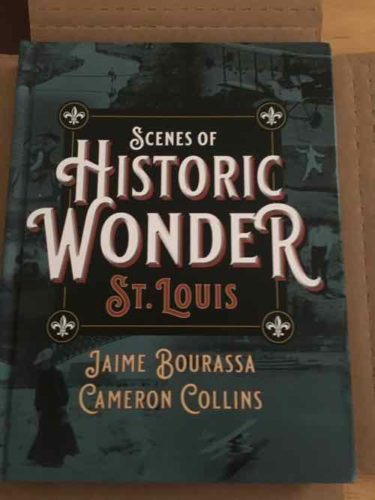New Book — ‘Scenes of Historic Wonder: St. Louis’ by Jaime Bourassa & Cameron Collins
 Local publisher Reedy Press comes out with many great books every year, usually on a specific subject. For example 2015’s ‘Downtown St. Louis’ by NiNi Harris (a 2nd edition was just released). Today’s book is different, the subjects are varied. The only common element is they’re oddities.
Local publisher Reedy Press comes out with many great books every year, usually on a specific subject. For example 2015’s ‘Downtown St. Louis’ by NiNi Harris (a 2nd edition was just released). Today’s book is different, the subjects are varied. The only common element is they’re oddities.
Quirky, provocative, awe-inspiring, and just plain bizarre describe the scenes captured in this often comical, always fascinating pictorial. The images in this singular collection depict one-of-a-kind moments that we’ll never see again, mainly because they reflect a specific place in time in history. Glimpses of everyday work, family, and public life not to mention scenes of leisure, sport, and entertainment convey what made each period unique. Informative captions place each scene in context and give substance to moments that range from mundane to wondrous and, in some cases, downright wacky. (Reedy Press)
Here’s a list of how the many topics are organized:
- Old St. Louis
- Transportation
- World’s Fair
- Sports
- Industry and Innovation
- Fun and Games
- Education
- Everyday Life
- Hard Times
- Brews and Food
In flipping through this book the last couple of weeks I’ve learned new things about St. Louis’ history, seen pictures I’d not seen before.
Here’s a small fraction of the subjects covered:
- Mound City, the opening subject is Native-American mounds that used to exist on the Missouri side of the Mississippi River.
- Kayser’s Lake, at 9th & Biddle, was one of many stagnant ponds to eventually be drained to get rid of disease and make room for development.
- The Campbell House Museum opened in the 1940s, but they didn’t have a good record of what the interior looked like in the past — but in 1973 a photo album from 1885 was found!
- In 1910 a biplane flew under a span of the Eads Bridge (obviously not during flooding).
- The 1906 demolition of the Farris wheel used in the 1904 World’s Fair, which had been used in 1893 fair in Chicago. Residents at the time considered it an “eyesore.”
- A steeply-banked wooden motordrome (motorcycle race track) used to exist at Grand and Meramec — that I new. The photograph, however, it not one I’d seem before.
- I also knew the zoo’s original location was on the east end of our current Fairgrounds Park (Grand & Natural Bridge), but the photo used is new to me.
- 3-story outhouse for tenements. Yes, a great photo of a 3-story outhouse structure with walkways to adjacent tenement buildings.
- St. Louis’ historic Chinatown area, commonly known as Hop Alley, razed in the 1960s for parking for the new baseball stadium.
- Homer G. Phillips Hospital, for African-Americans, was the result of segregation. It helped train thousands of black doctors and nurses. The photo used isn’t a building exterior shot, but a group of professionals inside working.
- Four Courts Building, 1870-1917, occupied the block bounded by Clark, 11th, Spruce, 12th (Tucker).
If you’re a St. Louis history buff this book needs to be on your coffee table or bookshelf.
— Steve Patterson